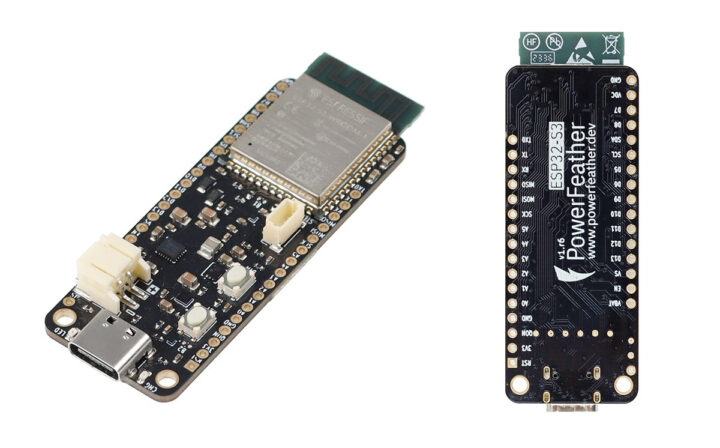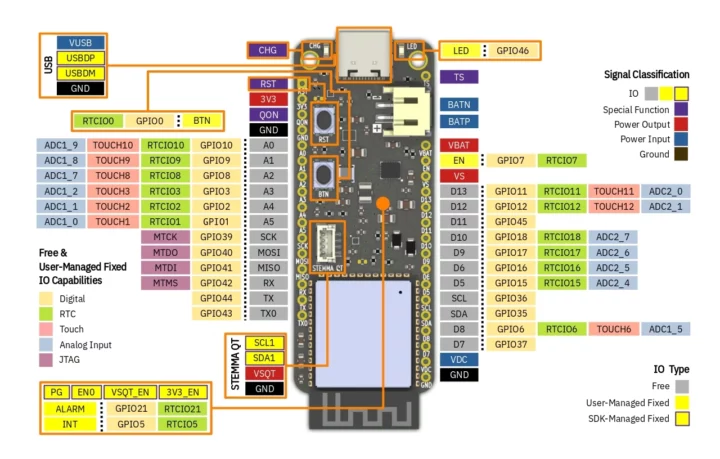The ESP32-S3 PowerFeather board is an Adafruit Feather-shaped ESP32-S3 WiFi and BLE IoT board that can be powered by a Li-Ion or LiPo battery and supports up to 18V DC input for direct connection to a solar panel.
The developer told CNX Software that the main differentiating factor from other ESP32-S3 development boards was “its extensive power management and monitoring features” with a wide DC input range, supply and battery monitoring, and battery protection features.
ESP32-S3 PowerFeather specifications:
- ESP32-S3-WROOM-1-N8R2
- MCU – ESP32-S3 dual-core Tensilica LX7 up to 240 MHz with 512KB SRAM, 16 KB RTC SRAM
- Memory – 2MB QSPI PSRAM
- Storage – 8MB QSPI flash
- Wireless – WiFi 4 and Bluetooth 5 LE + Mesh; PCB antenna
- USB – 1x USB-C 1.1 OTG port for power and programming
- Expansion
- 2x 16-pin 2.54 mm pitch headers with 23x multi-function GPIO:
- UART, I2C, SPI, I2S, SDIO, PWM, CAN, RMT, Camera, LCD capable
- Analog – 6x analog input capable
- 5x touch input capable
- 12x RTC capable (deep sleep pin hold, wake-up source)
- Semitec 103AT input on thermistor pinhole
- 4-pin JST SH STEMMA QT connector with I2C
- 2x 16-pin 2.54 mm pitch headers with 23x multi-function GPIO:
- Misc
- Charging status LED (red), user LED (green)
- User and Reset buttons
- Power Management
- Power Supply
- 5V/2A via USB-C port (VUSB)
- 3.8V to 18V DC/2A via VDC pin
- Up to 4.2V/2A via 2-pin JST PH Li-ion/LiPo battery connector; BQ25628E battery charger
- Maintained supply voltage (can be used to set MPP voltage)
- Output
- 3.3V up to 1A shared between board, 3V3 header pin and VSQT STEMMA QT connector
- 3.3V to 4.2V up to 3A shared between board and VBAT header pin
- 3.8V to 18 V up to 2A shared between board and VS header pin
- Torex XC6220 3.3V regulator
- Monitoring
- Supply – Current and voltage measurements, good supply detection
- Battery – Voltage, current (charge/discharge), and temperature measurements; charge estimation; health & cycle count estimation; time-to-empty and time-to-full estimation; low charge, high/low voltage alarm; LC709204F fuel gauge
- Battery protection
- Undervoltage Detect @ 2.2 V, Release @ 2.4 V
- Overvoltage Detect @ 4.37 V, Release @ 4.28 V
- Overcurrent protection @ 3A
- Trickle charging safety timer @ 1 hr
- Temperature-based charging current reduction based on JEITA, cutoff at 0 °C and 50 °C.
- Misc – 3V3 enable/disable; VSQT enable/disable
- Power States – Ship mode, Shutdown mode, and Power cycle
- Power Supply
- Power consumption using BATP (so about 3.7V?)
- Deep-Sleep, Fuel Gauge Enabled (Initial) – 26 μA
- Deep-Sleep, Fuel Gauge Enabled (Settled) – 18.5 μA
- Deep-Sleep, Fuel Gauge Disabled – 18 μA
- Ship Mode, Fuel Gauge Disabled – 1.5 μA
- Shutdown Mode, Fuel Gauge Disabled – 1.4 μA
- Dimensions – 65 x 23 x 7 mm (Adafruit Feather form factor, supports Feather Wings); 2x 2.5 mounting holes
The documentation looks pretty good with a detailed hardware description, and instructions to get started with the Arduino IDE using the PowerFeather-SDK library or the ESP-IDF. Documentation for the SDK’s API and guides to connect a solar panel and lower power consumption are also provided.
We had previously written about an ESP32-C6 board that claimed to support solar charging, but the DC input range was only 4.5 – 6V, and several CNX Software readers were unimpressed. The ESP32-S3 PowerFeather provides an improvement with a 3.8V to 18V DC range, plus it supports “pseudo-MPPT”:
PowerFeather does not support ‘true’ MPPT in the sense that it does not do full tracking of the panel’s I-V curve. However, the panel MPP voltage can be set, and the charger IC will dynamically regulate charging current to prevent the panel voltage from collapsing below it. This provides near/pseudo-MPPT performance, since the MPP voltage for a typical panel remains roughly the same across various illumination levels.
The ESP32-S3 PowerFeather board can be purchased on Elecrow for $30, and there’s also a small solar panel ($22) and a PowerFeather ProtoWing ($7) board for sale. A few more details may also be found on the official website.

Jean-Luc started CNX Software in 2010 as a part-time endeavor, before quitting his job as a software engineering manager, and starting to write daily news, and reviews full time later in 2011.
Support CNX Software! Donate via cryptocurrencies, become a Patron on Patreon, or purchase goods on Amazon or Aliexpress






That’s pretty cool. I’ve been modifying some existing DC-DC regulators in the past to implement this “pseudo-MPPT” consisting in “regulating” the input voltage, and it works particularly well. There are only a few percent extra efficiency to expect from going full MPPT in my opinion, so that’s really fine they did this.
Yep, that’s pretty cool but a litle bit overpriced IMHO.
Hello, designer of the board here. You can think of the board having the combined features of the following: Firebeetle 2 (8.9 USD) – for low quiescent currentDFRobot Solar Power Manager (7.9 USD) – for psuedo-MPPT, though this one has lower input voltage and lower fixed charging current compared to PowerFeatherAdafruit LC709203F Fuel Gauge (6.95) – though this one uses older LC709203F vs newer LC709204F on PowerFeather2 x DFRobot INA219 (2 x 6.9 USD) – one for the battery and the other for the supply. Except maybe one feature – 5 V output. If you do need one adding a… Read more »